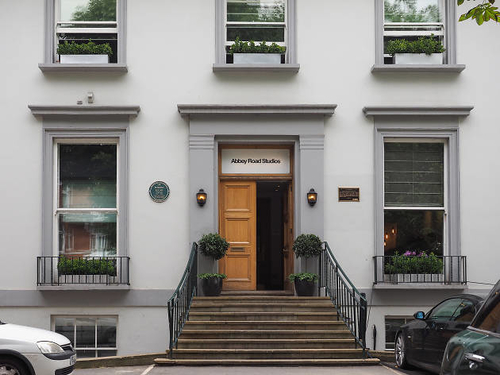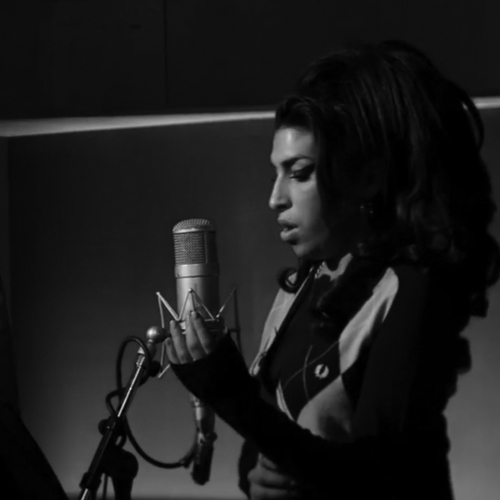FEATURE:
The Beatles’ Abbey Road at Fifty
PHOTO CREDIT: Abbey Road Studios
Inside the Iconic Studios
__________
THIS month is a pretty exciting one…
IN THIS PHOTO: The Beatles and George Martin at Abbey Road Studios/PHOTO CREDIT: Abbey Road Studios
if you are a fan of The Beatles. To be fair, most people are fans of The Beatles (or should be) but their final-recorded album, Abbey Road, turns fifty on 26th September. It is an iconic album that remains one of their very best and, from that memorable cover shot of the band walking across a zebra crossing to the brilliant songs on the album, it is a masterpiece. I think this will be the last big anniversary of a Beatles album where the two surviving members, Paul McCartney and Ringo Starr, are with us – seventy-five will be the next one and when their debut album, Please Please Me, hit that milestone, both will be in their nineties, I think (it could happen but it seems unlikely!). I cannot wait to see what celebrations are being held to mark fifty years of a truly wonderful album! It will nice to see McCartney and Starr tweet about it and fans will come together around the world. Whilst we celebrate the best band ever and a staggering album, let us think about where it was recorded. Abbey Road Studios is a hugely sought-after space where a lot of modern musicians record in – they are always bowled over when they enter the hallowed building! I have never been myself but, obviously, I have seen plenty of artists jam from the studio. I can only imagine how intimidating and thrilling it is standing on the steps outside of the studio and waiting to go in.
Of course, The Beatles are not the only legendary band/artist who have played there. Before I continue, I want to grab a little biography from the Abbey Road Studios’ website:
“Abbey Road Studios is the most famous recording studio in the world and a global music icon. Originally a nine-bedroom house built in 1829, it was purchased by the Gramophone Company in 1928 who went on to build the world’s first purpose-built recording studio. The St John’s Wood address was chosen for its large garden and ideal location – close enough to the performance spaces of the time, but away from the noise and vibrations of the traffic and trains.
The grand opening ceremony on 12 November 1931 included a performance of Land of Hope & Glory in Studio One conducted by Sir Edward Elgar. The Gramophone Company merged with Columbia Graphophone Company to form Electric and Musical Industries (EMI) in 1931, and the studios later became known as EMI Recording Studios. Since EMI engineer Alan Blumlein patented stereo at Abbey Road in 1931, the studios have been famed for innovation in recording technology, largely developed by the Record Engineering Development Department (REDD) who were responding to the needs of the artists and producers using the rooms. Their innovations include the REDD and TG desks, as well as studio techniques such as Artificial Double Tracking (ADT), created by studio technician Ken Townsend, who went on to become the studios’ MD, as well as Vice President of EMI Studios Group.
While initially a venue for classical recordings, the studios’ repertoire soon embraced jazz and big bands, too, as well as the first British rock & roll records of the 1950s, including Sir Cliff Richard’s first single Move It. Abbey Road is of course synonymous with the legendary work of The Beatles, who worked with EMI producer Sir George Martin and recorded 190 of their 210 songs at the studios. But Abbey Road’s unparalleled history spans the wild experiments of Pink Floyd to iconic recordings from Shirley Bassey, Aretha Franklin, The Hollies and many more.
Since those exceptional years, artists from Kate Bush, Radiohead, Oasis, Kanye West, Amy Winehouse, Kylie and Muse to Sam Smith, Florence + The Machine, Ed Sheeran, Frank Ocean, Lady Gaga and Adele have made Abbey Road their creative home, producing countless landmark recordings.
As the demand for classical recording spaces declined, Ken Townsend found a new role for the big rooms – movie scores, with the first major film score being Raiders of The Lost Ark in 1980. Since then, Abbey Road has developed into one of the world’s premier destinations for movie scoring. Blockbuster films such as The Lord of The Rings Trilogy, Skyfall, the Harry Potter series and the Oscar-winning Gravity feature scores recorded here, while recent projects include Black Panther, Solo: A Star Wars Story and the multi award winning The Shape of Water.
The studios house a number of state-of-the-art mastering suites, with engineering expertise spanning direct to vinyl and half-speed mastering. Recent projects mastered or re-mastered by Abbey Road’s award-winning engineers include music from The Beatles, Sam Smith, Sade, Abba, Krept & Konan, Graham Coxon, Novelist, Johnny Marr, Roxy Music and The Rolling Stones.
IN THIS PHOTO: The late Amy Winehouse looking focused at Abbey Road Studios/PHOTO CREDIT: Abbey Road Studios
In Spring 2017, in the biggest transformation since first opening, two new contemporary studios were launched - The Gatehouse and The Front Room - making the magic of Abbey Road accessible to a whole new generation of recording artist. They have already hosted artists from James Bay, Jess Glynne, George Ezra and Skrillex to legends like Nile Rodgers plus grime MCs Novelist and Jammer BBK”.
Not only is Studio 2 famous for its sheer size but the artists who have laid down tracks there is amazing! Films are scored there and Abbey Road Studios also does post-production mastering. It truly is a space where artists can create and be inspired. One of my ambitions is to walk around the studios and get a feel for what artists do; the sheer amazement being in that space! Since bands like The Beatles started pushing the possibilities of the studio from the 1960s, some amazing acts have pushed boundaries and made discoveries in Abbey Road Studios. To celebrate fifty years since Abbey Road came into the world, BBC Radio 2 are celebrating with a four-day pop-up DAB station. You can find more details here and get involved. One might say these celebrations are excessive considering we are marking one album but, when you consider The Beatles define the studios and have encouraged countless artists to record there, one can forgive a little excess and pomp.
Abbey Road Studios’ Isabel Garvey is one of the most influential and creative people in the music world and she is definitely taking the studios into the future. There have been threats in the past of closure and, when you read the reasons, it would have been a travesty if we saw the end of such an historic building. Garvey is bringing AI to Abbey Road Studios and her incredible team continues to welcome in the best establishes and rising artists. That is the beauty of the place: the fact that a relatively unknown artist might walk in a record and bump into a legend on their way out! I do wonder whether, as part of Abbey Road turning fifty, the public will be allowed access into the studios. Certainly, thousands flock to the famous zebra crossing outside the studios (although I believe it is not the exact same one The Beatles used for the Abbey Road cover) and it would be a dream for many to take a tour of this iconic place. 26th September is when Abbey Road turns fifty but, to all music fans, do some digging and get to know Abbey Road Studios. If you are near Abbey Road Studios at 3 Abbey Rd, St John's Wood, London NW8 9AY then take a trip across the famous zebra crossing; see their graffiti wall and just take in the atmosphere! This month, the revered and sensational studios will be…
FIRMLY in the spotlight.



